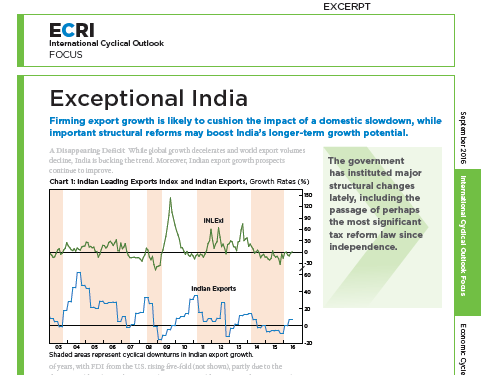Lakshman Achuthan,
 Powered by a rush of foreign investment, Indian stock prices surged to a new high last week. Posting double-digit returns year-to-date, Indian equities have outperformed stocks in the other BRIC economies, as well as the U.S. Also - while declining globally - foreign direct investment into India spurted to an eight-year high in 2016, exceeding India’s current account deficit for the first time since economic liberalization a quarter-century ago.
Powered by a rush of foreign investment, Indian stock prices surged to a new high last week. Posting double-digit returns year-to-date, Indian equities have outperformed stocks in the other BRIC economies, as well as the U.S. Also - while declining globally - foreign direct investment into India spurted to an eight-year high in 2016, exceeding India’s current account deficit for the first time since economic liberalization a quarter-century ago.
Back in September, in the face of a less hopeful consensus about India’s prospects, ECRI presented a contrarian report titled “Exceptional India." The report noted that, “bucking the [global] trend … Indian export growth prospects continue to improve," according to ECRI’s Indian Leading Exports Index.

We also highlighted India’s demographic advantages, as “the only major economy where the prime-age population - aged 20 to 64 - is projected to rise as a percentage of the total population in the 2015-25 period." This is in sharp contrast to most developed economies, as shown on page 3 of ECRI’s January 2017 presentation.
Key structural changes were also noted, including last summer’s enactment of “India’s most significant tax reform since independence in 1947 … the long-pending Goods and Services Tax (GST), consolidating India’s plethora of indirect taxes, duties, surcharges and levies into a single tax [that will] … transform the Indian economic landscape by creating effectively a single market. With some 7½ million businesses expected to be covered by the tax, Indian software giant Infosys is building the massive infrastructure for a GST portal, where taxpayers can register, make payments and file returns."
Infosys’s erstwhile CEO, Nandan Nilekani - who had explained to Thomas Friedman in the early years of the century why “the world is flat" - left Infosys in 2009 to head up the Unique Identification Authority of India, responsible for implementing the Aadhar card project. The Aadhar card is the basis for the world’s first national digital infrastructure, with 95% of the population - nearly half of whom had possessed no ID at all in 2009 - now having a digital proof of identity that will soon enable government and businesses alike to implement remote, paperless and cashless service delivery systems. This is one of the biggest potential disruptors of “business as usual" the world has ever seen.
It was in this context that last November’s surprise demonetization took place, as a “shock-and-awe" move to force a large part of the unbanked population into the banking system. While the overwhelming majority of commentators and pundits kept criticizing the move for months, focusing on the magnitude of the disruption to everyday life, we described it in our November 2016 report following that event as “one of a series of anti-corruption measures that the government has planned, while attempting to move India towards a ‘less cash economy.’" We knew that “Indian economic growth is practically certain to take a serious hit due to the sudden liquidity squeeze in [Q4 2016] and the first quarter of 2017 before returning to its prior trajectory. The point is that people are willing to suffer such temporary inconveniences if it means that the corrupt are penalized, even if this is no master-stroke that eradicates corruption."
To the surprise of most analysts, the Reserve Bank of India (RBI) did not cut rates to support the economy in its next monetary policy meeting. The RBI’s Monetary Policy Committee justified the move in part by noting: “On the basis of the Indian leading indices produced by the Economic Cycle Research Institute (ECRI), it can be inferred that the Indian economy was in a resilient state ahead of the decision to withdraw SBNs. … Specifically, with the Indian Leading Index growth in a clear cyclical upswing and rising to a two-year high before the withdrawal of SBNs, the economic growth outlook going into the autumn months had become increasingly optimistic, underscoring the economy’s resilience to potential negative shocks. Thus, from a business cycle perspective, at the time, the Indian economy was not vulnerable. …. In this backdrop, the withdrawal of SBNs is expected to have only a transitory impact on economic activity."
Sure enough, the Indian economy is already rebounding from the shock. Unlike other major economies for which the “simple math" of dismal demographics and declining productivity growth dictates a decline in long-term trend growth, India actually has favorable demographics, and is in the process of implementing dramatic structural changes that will potentially provide a major boost to productivity. With India’s demographic advantages and transformative policy changes starting to filter through to the consensus, while the reality of the cyclical resilience ECRI had highlighted back in the fall begins to dawn on them, the rush to “exceptional India" has begun in earnest.
No comments:
Post a Comment